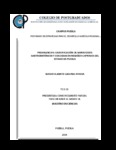| dc.contributor.author | Lagunes Rivera, Sergio Alberto | |
| dc.creator | LAGUNES RIVERA, SERGIO ALBERTO; 440907 | |
| dc.date.accessioned | 2014-07-31T01:30:53Z | |
| dc.date.available | 2014-07-31T01:30:53Z | |
| dc.date.issued | 2014 | |
| dc.identifier.uri | http://hdl.handle.net/10521/2354 | |
| dc.description | Tesis (Maestría en Ciencias, especialista en Estrategias para el Desarrollo Agrícola Regional).- Colegio de Postgraduados, 2014. | en_US |
| dc.description.abstract | La caprinocultura se desarrolla en el 73% de los municipios del estado de Puebla, a altitudes de 900 a 3,000 msnm, donde las condiciones ambientales pueden influir en la presencia de parasitosis. El objetivo del estudio fue determinar la prevalencia de parásitos gastrointestinales e identificar los géneros de nematodos que afectan a los caprinos, en función de tres estratos fisiológicos de los animales y de tres zonas climáticas. El muestreo se realizó en 49 rebaños ubicados en municipios con importancia caprina, los cuales se agruparon en tres zonas en función de su altitud, temperatura y precipitación. En cada rebaño se muestrearon tres estratos de animales: hembras primalas, adultas y sementales, colectando respectivamente, 236, 262 y 50 muestras de 20 g de heces. Con la técnica McMaster se realizó individualmente el conteo de huevos de nematodos y de ooquistes de coccidias (Num/g de heces). En muestras compuestas por estrato de animal de cada rebaño, se realizó un coprocultivo por la técnica de Corticeli y Lai, para identificar los géneros presentes. El análisis estadístico se realizó mediante la prueba de Kruskal-Wallis en el programa estadístico SAS. Las medias generales de conteos fueron de 921 huevos de nematodos y de 1307 ooquistes de coccidia, encontrándose que las zonas y el estrato animal influyen sobre el número de huevos de nematodos (P<.0001), pero no de ooquistes de coccidia. Las medias de prevalencias de nematodos y coccidias en las cabras fueron de 86% y 93%, respectivamente; existiendo un efecto significativo (P<.0001) en función de la zona y el estrato animal. Los géneros identificados de nematodos fueron Haemonchus, Teladorsagia, Strongyloides y Chabertia, que representaron respectivamente 64%, 19%, 9% y 8% de las larvas identificadas. _______________ PREVALENCE AND IDENTIFICATION OF GASTROENTERIC NEMATODES AND COCCIDIAN IN GOAT FLOCKS AT THE STATE OF PUEBLA, MEXICO. ABSTRACT: Goat raising in the state of Puebla is carried out in 73% of the municipalities, at altitudes from 900 to 3,000 masl, where environmental conditions can influence the presence of parasitic diseases. The aim of the study was to determine the prevalence of gastrointestinal parasites and identify nematodes affecting goats, according to three physiological animal strata and three climatic zones. Sampling was performed in 49 herds located in municipalities with goat production importance, which were grouped into three zones according to altitude, temperature and precipitation. In each herd, three strata (yearling and adult females, as well as stallions) were sampled, collecting 236, 262 and 50 samples of 20 g of feces, respectively. With the McMaster technique, the counting of nematode eggs and coccidial oocysts (Number / g feces) was performed individually. In pooled samples of each animal stratum by herd, stool cultures using the Corticeli and Lai technique to identify genera present were performed. Statistical analysis was performed using the Kruskal-Wallis test, in the SAS programme. The count averages were 921 nematode eggs and 1307coccidial oocysts, finding that the areas and the animal stratum influence (P <.0001) the number of nematode eggs, but no coccidia oocyst. The mean prevalence of nematodes and coccidia in goats were 86 % and 93 %, respectively; there was a significant (P < 0.0001) effect depending on the area and the animal stratum. The genera identified were Haemonchus, Teladorsagia, Strongyloides and Chabertia, which accounted for 64 %, 19%, 9% and 8 % of identified larvae. | en_US |
| dc.description.sponsorship | Consejo Nacional de Ciencia y Tecnología (CONACYT). | en_US |
| dc.language.iso | spa | en_US |
| dc.subject | Haemonchus | en_US |
| dc.subject | Parásitos | en_US |
| dc.subject | Pequeños rumiantes | en_US |
| dc.subject | SIG | en_US |
| dc.subject | GIS | en_US |
| dc.subject | Parasites | en_US |
| dc.subject | Small ruminants | en_US |
| dc.subject | Estrategias para el Desarrollo Agrícola Regional | en_US |
| dc.subject | EDAR | en_US |
| dc.subject | Maestría | en_US |
| dc.title | Prevalencia e identificación de nematodos gastroentéricos y coccidias en rebaños caprinos del estado de Puebla | en_US |
| dc.type | Tesis | en_US |
| Tesis.contributor.advisor | Calderón Sánchez, Francisco | |
| Tesis.contributor.advisor | Vargas López, Samuel | |
| Tesis.contributor.advisor | Guerrero Rodríguez, Juan de Dios | |
| Tesis.contributor.advisor | Mendoza de Gives, Pedro | |
| Tesis.contributor.advisor | Liebano Hernández, Enrique | |
| Tesis.date.submitted | 2014 | |
| Tesis.date.accesioned | 2014-07-22 | |
| Tesis.date.available | 2014-07-30 | |
| Tesis.format.mimetype | pdf | en_US |
| Tesis.format.extent | 3,906 KB | en_US |
| Tesis.subject.nal | Rebaños | en_US |
| Tesis.subject.nal | Flocks | en_US |
| Tesis.subject.nal | Nematodos parásitos de animales | en_US |
| Tesis.subject.nal | Animal parasitic nematodes | en_US |
| Tesis.subject.nal | Composición de las heces | en_US |
| Tesis.subject.nal | Feces composition | en_US |
| Tesis.subject.nal | Teladorsagia | en_US |
| Tesis.subject.nal | Strongyloides | en_US |
| Tesis.subject.nal | Chabertia | en_US |
| Tesis.subject.nal | Larvas | en_US |
| Tesis.subject.nal | Larvae | en_US |
| Tesis.subject.nal | Puebla, México | en_US |
| Tesis.rights | Acceso abierto | en_US |
| Articulos.subject.classification | Cabras | en_US |
| dc.type.conacyt | masterThesis | |
| dc.identificator | 5 | |
| dc.contributor.director | CALDERON SANCHEZ, FRANCISCO; 36405 | |

